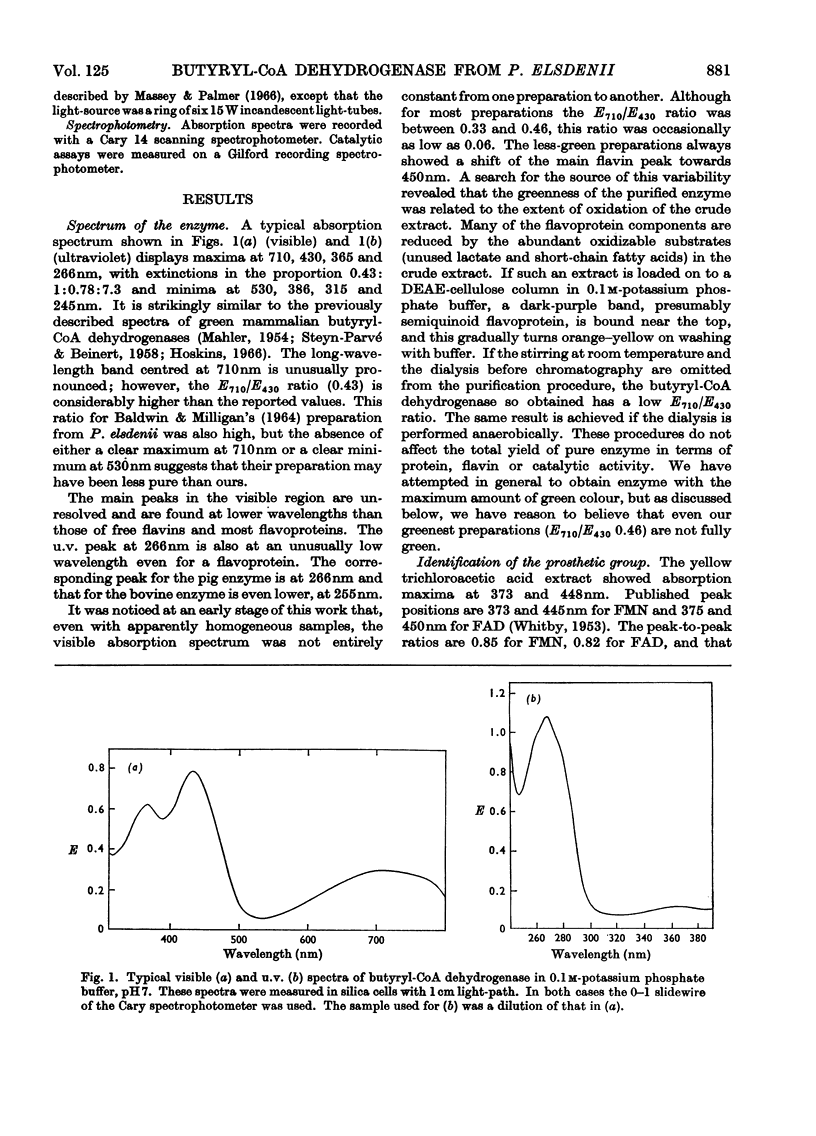Abstract
Butyryl-CoA dehydrogenase prepared by a simple procedure from Peptostreptococcus elsdenii has a molecular weight of approx. 150000. The enzyme has FAD as its prosthetic group. The amino acid analysis is reported. This enzyme, like most of the corresponding mammalian ones, is green. The absorption band at 710nm can be abolished irreversibly by dithionite reduction and air reoxidation; it can be abolished reversibly by phenylmercuric acetate or potassium bromide. The enzyme as isolated appears to be a mixture of a green and a yellow form, both of which are active. This view is supported by the variable `greenness' of different preparations and the biphasic curve obtained in anaerobic spectrophotometric titrations with dithionite. It can be calculated from the titration results that fully green enzyme would have a peak-to-peak absorption ratio (E710/E430) as great as 0.54. The green form is much less rapidly reduced by dithionite than the yellow form, but is nevertheless much more readily reduced by dithionite than the enzyme from pig liver. It is also more readily reoxidized by air and shows less tendency to form a semiquinone. Treatment with sodium borohydride produces an unusual reduced species that is probably the 3,4-dihydroflavin.
Full text
PDF








Selected References
These references are in PubMed. This may not be the complete list of references from this article.
- Andrews P. Estimation of the molecular weights of proteins by Sephadex gel-filtration. Biochem J. 1964 May;91(2):222–233. doi: 10.1042/bj0910222. [DOI] [PMC free article] [PubMed] [Google Scholar]
- BALDWIN R. L., MILLIGAN L. P. ELECTRON TRANSPORT IN PEPTOSTREPTOCOCCUS ELSDENII. Biochim Biophys Acta. 1964 Dec 23;92:421–432. doi: 10.1016/0926-6569(64)90001-x. [DOI] [PubMed] [Google Scholar]
- CAVALLINI D. The coupled oxidation of pyruvate with glutathione and cysteine. Biochem J. 1951 Jun;49(1):1–5. doi: 10.1042/bj0490001. [DOI] [PMC free article] [PubMed] [Google Scholar]
- CRANE F. L., BEINERT H. On the mechanism of dehydrogenation of fatty acyl derivatives of coenzyme A. II. The electron-transferring flavoprotein. J Biol Chem. 1956 Feb;218(2):717–731. [PubMed] [Google Scholar]
- CRANE F. L., MII S., HAUGE J. G., GREEN D. E., BEINERT H. On the mechanism of dehydrogenation of fatty acyl derivatives of coenzyme A. I. The general fatty acyl coenzyme A dehydrogenase. J Biol Chem. 1956 Feb;218(2):701–706. [PubMed] [Google Scholar]
- Coffey D. S., Neims A. H., Hellerman L. Studies on crystalline D-amino acid oxidase. II. Isolation of a reduced 14C-labeled substrate-enzyme intermediate after the action of sodium borohydride. J Biol Chem. 1965 Oct;240(10):4058–4064. [PubMed] [Google Scholar]
- ELSDEN S. R., GILCHRIST F. M., LEWIS D., VOLCANI B. E. Properties of a fatty acid forming organism isolated from the rumen of sheep. J Bacteriol. 1956 Nov;72(5):681–689. doi: 10.1128/jb.72.5.681-689.1956. [DOI] [PMC free article] [PubMed] [Google Scholar]
- ELSDEN S. R., LEWIS D. The production of fatty acids by a gram-negative coccus. Biochem J. 1953 Aug;55(1):183–189. doi: 10.1042/bj0550183. [DOI] [PMC free article] [PubMed] [Google Scholar]
- Engel P. C., Massey V. Green butyryl-coenzyme A dehydrogenase. An enzyme-acyl-coenzyme A complex. Biochem J. 1971 Dec;125(3):889–902. doi: 10.1042/bj1250889. [DOI] [PMC free article] [PubMed] [Google Scholar]
- Foust G. P., Burleigh B. D., Jr, Mayhew S. G., Williams C. H., Jr, Massey V. An anaerobic titration assembly for spectrophotometric use. Anal Biochem. 1969 Mar;27(3):530–535. doi: 10.1016/0003-2697(69)90066-9. [DOI] [PubMed] [Google Scholar]
- GREEN D. E., MII S., MAHLER H. R., BOCK R. M. Studies on the fatty acid oxidizing system of animal tissues. III. Butyryl coenzyme A dehydrogenase. J Biol Chem. 1954 Jan;206(1):1–12. [PubMed] [Google Scholar]
- Hellerman L., Coffey D. S. Studies on crystalline D-amino acid oxidase. V. Characterization of borohydride-reduced enzyme-subtrate intermediate. Synthesis of epsilon-N-(1-carboxyethyl)-L-lysine. J Biol Chem. 1967 Feb 25;242(4):582–589. [PubMed] [Google Scholar]
- Hoskins D. D. The electron-transferring flavoprotein as a common intermediate in the mitochondrial oxidation of butyryl coenzyme A and sarcosine. J Biol Chem. 1966 Oct 10;241(19):4472–4479. [PubMed] [Google Scholar]
- MAHLER H. R. Studies on the fatty acid oxidizing system of animal tissues. IV. The prosthetic group of butyryl coenzyme A dehydrogenase. J Biol Chem. 1954 Jan;206(1):13–26. [PubMed] [Google Scholar]
- Massey V., Curti B., Müller F., Mayhew S. G. On the reaction of borohydride with D- and L-amino acid oxidases. J Biol Chem. 1968 Mar 25;243(6):1329–1330. [PubMed] [Google Scholar]
- Mayhew S. G., Massey V. Purification and characterization of flavodoxin from Peptostreptococcus elsdenii. J Biol Chem. 1969 Feb 10;244(3):794–802. [PubMed] [Google Scholar]
- Müller F., Massey V., Heizmann C., Hemmerich P., Lhoste J. M., Gould D. C. The reduction of flavins by borohydride: 3,4-dihydroflavin. Struction, absorption and luminescence. Eur J Biochem. 1969 Jun;9(3):392–401. doi: 10.1111/j.1432-1033.1969.tb00621.x. [DOI] [PubMed] [Google Scholar]
- STEYN-PARVE E. P., BEINERT H. On the mechanism of dehydrogenation of fatty acyl derivatives of coenzyme A. VII. The nature of the green color of butyryl dehydrogenase. J Biol Chem. 1958 Oct;233(4):853–861. [PubMed] [Google Scholar]
- Spencer R. L., Wold F. A new convenient method for estimation of total cystine-cysteine in proteins. Anal Biochem. 1969 Oct 15;32(1):185–190. doi: 10.1016/0003-2697(69)90123-7. [DOI] [PubMed] [Google Scholar]
- WHITBY L. G. A new method for preparing flavin-adenine dinucleotide. Biochem J. 1953 Jun;54(3):437–442. doi: 10.1042/bj0540437. [DOI] [PMC free article] [PubMed] [Google Scholar]


